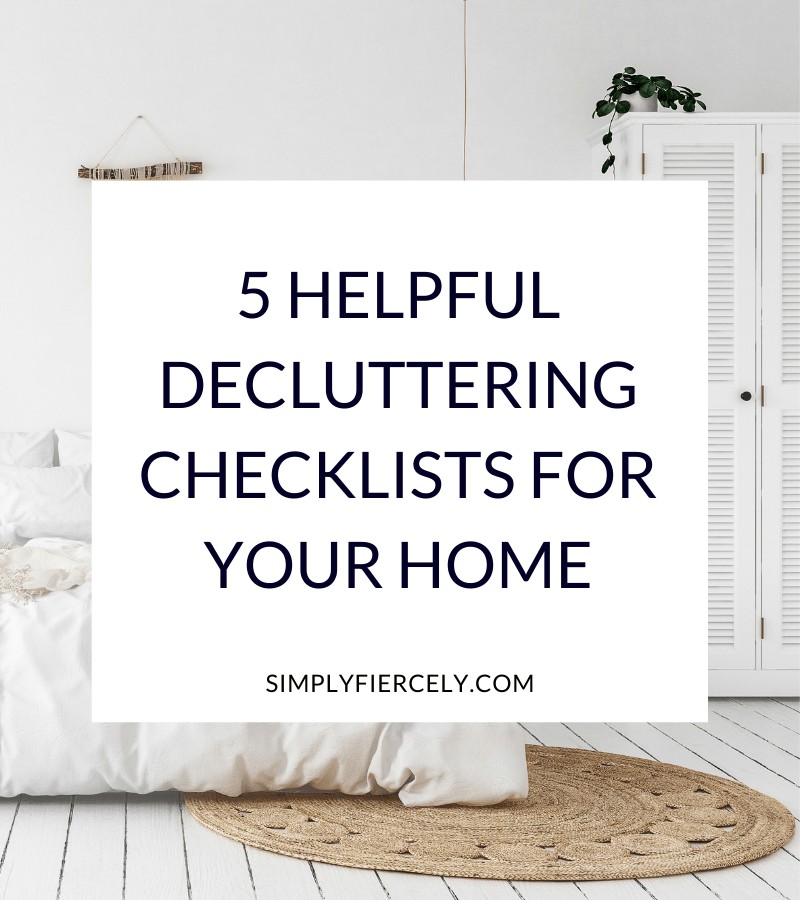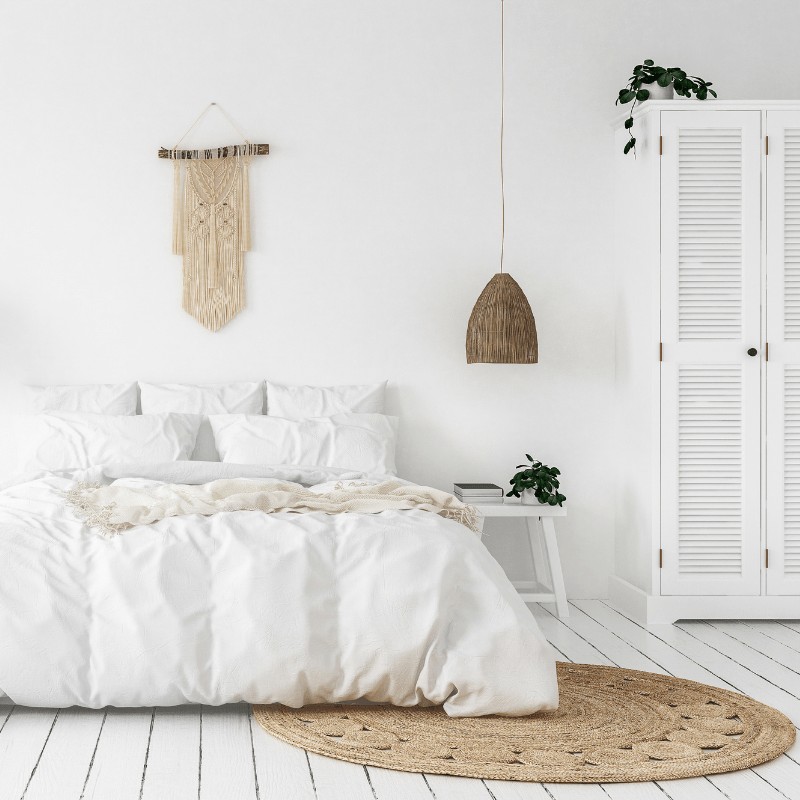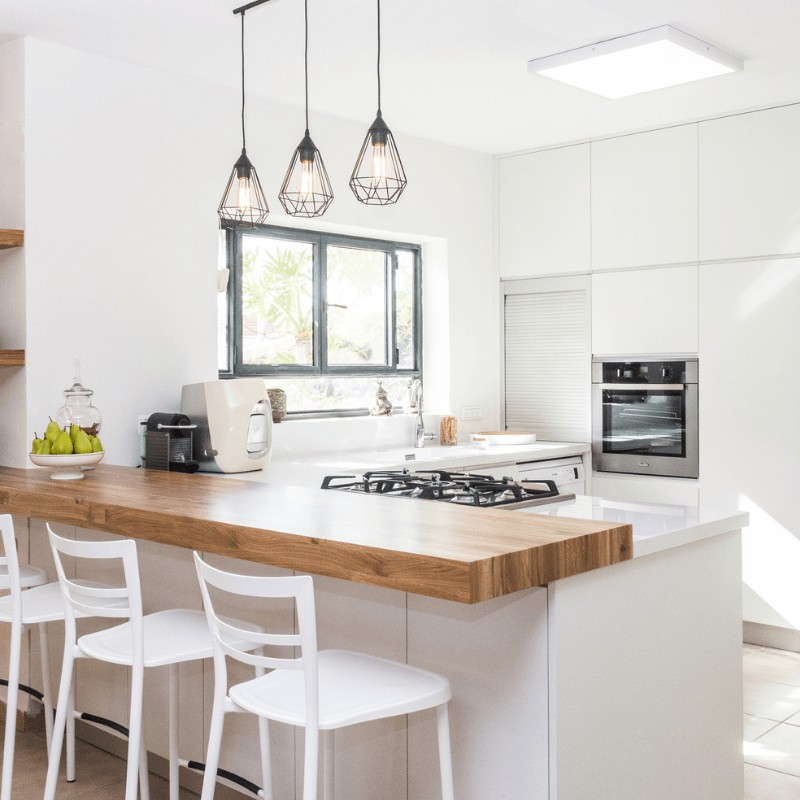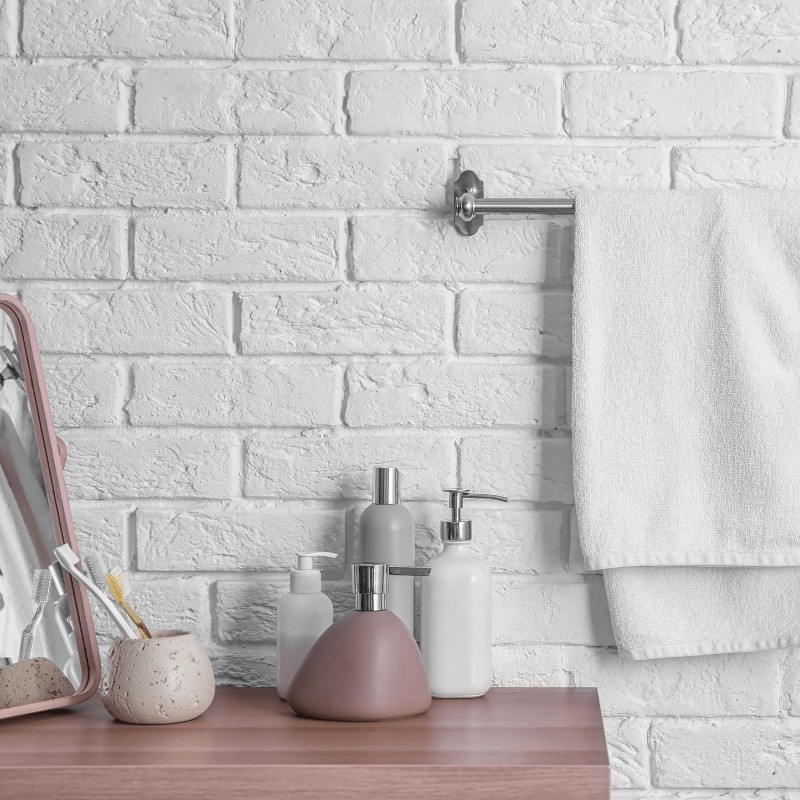Inside: These decluttering checklists and practical tips will help you clear the clutter with less stress.
I know that one of the hardest parts of decluttering is just getting started. When you have your entire home to go through, it can be overwhelming—there’s so much stuff and so little time!
Plus, odds are you have a lot on your plate (between work, family, and life), and you’re tired of making decisions. Sometimes you just want to be told what to do, which is what probably brought you to this blog post.
Don’t worry, I’ve got your back. This collection of decluttering checklists, along with some of my top tips, will take the stress and overwhelm out of decluttering your home. Let’s get started!

How to Use A Checklist For Decluttering
Before I share the checklists with you, I think it’s essential to clarify something.
There is no such thing as a “one-size fits all” decluttering checklist.
Everyone’s decluttering journey is personal, and there are no rules about what you can and can’t keep. Don’t let anyone or anything (including these checklists) make you feel bad about holding on to an item that adds value to your life.
Minimalism and simplifying are NOT about deprivation. Instead, it’s about peace of mind and creating a space that reflects your values and priorities.
This is the reason why I haven’t shared any decluttering checklists in the past. Instead, I generally recommend creating your own (but more on that in a moment). For now, I’ve decided these lists can be helpful as long as you use them for inspiration—a bit like a conversation starter. As you go through each item on the list, ask yourself why you’ve kept it. Then let your answers guide your actions.
Declutter Your Home With These Checklists
Bedroom checklist
Your bedroom is the perfect place to start decluttering because it’s where you retreat at the end of the day. If it feels light and open, you’ll find it easier to rest and recharge. But if you have too much clutter, you’ll find it hard to relax and recharge at the end of the day.
Keep that in mind as you work through your bedroom. This list of things is a starting point, but at the end of the day, you may want to reconsider anything that’s not contributing to a sense of calm.
- Paperwork – Paperwork is almost always a reminder of things you should be doing, and it can add a lot to your mental load. I recommend minimising the number of papers you keep in all areas of your home, but especially in the bedroom.
- Clothes that no longer fit or you no longer wear – Keeping clothes that don’t fit or you don’t wear takes up valuable space in your bedroom closet, making it harder to find and use the clothes you do want to wear.
Helpful Resource: How to Declutter Your Closet For Good: An Ultimate Guide
- Unfinished projects – Another common source of bedroom clutter is unfinished projects—from that scrapbook you’re going to make ‘someday’ to that half-knit sweater. Be realistic about what you’re going to finish, or at a minimum, get them out of your bedroom.
- Excessive decorations or knick-knacks – While a few decorations can add character to a space, clearing surfaces is the easiest way to add tranquillity to your space. Be intentional about what you decide to keep.
- Trash, random receipts, and “pocket items” – I find that our bedrooms (especially the bedside table) tend to attract what I call “pocket items”—the random stuff that lives in our pockets, the bottom of our purses, etc.
Related Post: 4 Thoughtful Questions to Ask When Decluttering
- Books that you’ve already read or no longer plan to read – Holding on to books that you’ve already read (when you know you’ll never read again) or have no intention of reading can take up valuable space and make it harder to find and read the books you actually want to read.
- Broken or unused electronics – Keeping broken or unused electronics take up valuable space and can create clutter in your bedroom.

Living room checklist
The living room (or family room) is often a place where people gather to enjoy each other’s company. Which is great—except it often becomes a dumping ground for everyone’s stuff.
This is a problem because no one wants to hang out in a storage space. When there’s a lot of clutter, it can be hard to enjoy quality time together, which is why this list is so important.
- Old magazines and newspapers – Are there old magazines and newspapers cluttering your coffee table? Or perhaps “organised” in a stylish magazine holder that acts more like a black hole (items are placed inside never to be read again!). Be realistic about what’s worth keeping and put the rest in the recycling bin.
- DVDs, CDs, or other media that you no longer watch or listen to – Especially if you rely on streaming services (Netflix, Spotify, etc.). I know it’s tempting to keep hard copies, but if you have a small space, be realistic about what’s worth keeping.
- Furniture that is uncomfortable or no longer serves a purpose – This is so rarely talked about, but it is a great tip. Decluttering furniture can make your home look spacious with minimal effort.
Related Post: 7 Secrets of a Decluttered Home
- Extra blankets or pillows that are rarely used – If you find yourself constantly folding blankets and moving around pillows, ask yourself if anyone is actually using them. Or are they just cluttering your home?
- Toys or games that are no longer played with – If you don’t have a playroom, toys are usually a huge source of living room clutter. Pay attention to what your kids actually play with—you mind find that extra space is more effective than extra stuff when. it comes to keeping little ones entertained.
- Old electronics – Do you still need that VCR? Or your CD player? Just something to consider …
- Cords and cables that are no longer needed – I know that a lot of people have a hard time decluttering random cords, but if you don’t know what they’re, you’re never going to use them.
Helpful Resource: How To Get Rid Of Stuff Like a Minimalist
Kitchen checklist
The kitchen can often feel like the most overwhelming room to tackle, with so many nooks and cubbies hiding all sorts of things! But don’t worry—this helpful checklist will help you get started.
- Expired food – Expired food not only takes up valuable space in your kitchen but can also be harmful to your health if consumed. Check the expiration dates of your food items and get rid of any that have expired.
- Duplicate or unnecessary kitchen tools – Having too many kitchen tools can create clutter and make it harder to find and use the tools you actually need. Donate or sell any you’re not using.
- Chipped or cracked dishes and glasses – Chipped or cracked dishes and glasses not only take up space in your kitchen but can also be dangerous to use as they can break or shatter easily.
- Small appliances that you rarely use – I’m looking at you, juicer and breadmaker! Of course, keep what you actually use! But sometimes, we buy these things because we aspire to use them. Don’t feel bad about admitting that’s not who you are.
Helpful Resource: How to Create a Minimalist Pantry For Your Kitchen
- Plastic containers without lids or vice versa – If you can find a way to use them, great. But if not, let them go. (Quick tip: in the future buy ones where the lids can be mixed and matched or easily replaced. Alternatively, recycle food containers to reduce waste.)
- Cookbooks that you rarely use – Again, if you love them AND use them, keep them! But just remember how easy it is to find and save recipes online.
- Single-use kitchen gadgets – Single-use kitchen gadgets, like avocado slicers or strawberry hullers, take up valuable space in your kitchen. Ask yourself if they are actually helpful or if you’d rather have your space back.
- The junk drawer – Almost everyone has one—but should you? I have a theory that clutter gathers wherever we allow it space to grow. Why not find a new home for the contents of your junk drawer, and try repurposing the space for something else?
Related Post: Simple Eating: How I Learned to Save Money, Reduce Stress + Spend Less Time in the Kitchen

Kids’ bedroom checklist
Decluttering the kids’ bedrooms can be a great project to do together. It gives you a chance to teach the importance of being intentional, and it also helps them feel better about letting things go. But here’s a quick tip before we dive into the checklist: motivate your kids by appealing to their values. How will owning less stuff help them have more of what matters to them?
For example, I never tell my daughter that she has to declutter. But every time she complains about cleaning up, I remind her it would be easier if she had less stuff. I also point out things like how having fewer toys on the floor means more space for things like her train set. She’s still young, so I don’t push her to let go. But explaining the trade-offs in an age-appropriate way has actually led to her wanting to declutter all on her own!
- Clothes that don’t fit – Kids outgrow their clothing quickly, so it’s important to regularly go through their closets and drawers to get rid of things that no longer fit. This creates space for new clothing that your child will actually wear.
- Toys or games – This is always a tough one, but I like to start by making sure everything goes in its proper place. Then look at what’s left—if you don’t know where to put it, there’s a good chance it’s time to declutter it.
- Artwork or school papers – I find the best way to deal with kids’ artwork is to have a rotating system. We hang things up so every family member can appreciate them, but when new things come home, old things have to go.
- Excess stuffed animals You know the drill! But here’s a quick tip to reduce decision fatigue: instead of asking your kid what they want to declutter, choose two items and ask them to pick which one they want to keep.
Related Post: A Helpful Guide to Minimalism With Kids
- Books they no longer read – Here’s a tip: the first thing I do is pull out books and place them where my kids can see them. If they spark an interest, I’ll usually keep them and add them to a toy rotation. But if they ignore them, I pass them on to someone else.
- Rocks, sticks and other random items – You can even make a game of it! Take the kids outside and let them hide their treasures for others to find.
- Craft supplies – If they’re dried out and unusable, put them in the bin or recycling. But if they’re still usable, my favourite way to “declutter” craft projects is by using them! Get creative and burn through the excess.
Bathroom checklist
If you find yourself digging through a bin of mostly unused samples to get to the one item you need, it might be time for a bathroom declutter! The number of small tubes and bottles that end up in our bathrooms can be enough to overwhelm anyone, but this checklist should help you begin.
- Expired or unused medications – Expired medications can be ineffective or even dangerous and can take up valuable space in your medicine cabinet. Properly dispose of any expired or unused medications (a lot of pharmacies will accept them).
- Old or expired makeup – I know, we all do it …. but it’s kind of gross. Old or expired makeup can harbour bacteria and cause skin irritation or infections.
Related Post: How to Create a Minimalist Beauty Routine (Skincare + Makeup Essentials)
- Empty or almost-empty bottles – I hate to be wasteful, so one tip is cutting open bottles that only have a little bit of product left. Alternatively, if you have stuff that you’ve never used (still unopened and not expired), many charities will accept these goods.
- Old towels – A lot of animal charities will accept old towels, or you can downgrade them to cleaning supplies (I know that’s not technically decluttering, but I always prefer to use things up before getting rid of them.)
- Hair accessories, dried-up nail polish, dull razors, old cleaning products – there’s a lot of stuff that lives under the sink or in the bottom of drawers. Give it all a once over!
Other areas to consider
Don’t feel pressured to declutter your entire house in one weekend (or even one month). It took time to accumulate your clutter, and it will take time to let go. Focus on the areas that will have the biggest impact on your life, and then you may also want to consider:
- laundry room – What’s hiding in your laundry baskets? mending projects? dry cleaning? Is it time to let go?
- linen closet – How much is enough? everyone is different, but we keep 2 sets for every bed
- home office – What papers or reference materials are you saving that you no longer need? Old calendars, rubber bands, and other odds and ends that you no longer need.
- digital clutter – Go through your hard drive, your emails, and even your social media accounts. Don’t be afraid to unsubscribe and delete!

How to Create Your Own Decluttering Checklist (And Why You Should)
I hope that you found these checklists helpful, but as I mentioned earlier in this post, I also recommend that you create a personalised list. There are two important reasons for doing this:
- Your list should be a reflection of what matters most to you. What you need to “let go” of will be different depending on your values and priorities.
- The act of writing the list is actually an essential part of the decluttering process. Trust me—if you want to clear your clutter for good, then you have to tackle the thoughts and beliefs that led to clutter in the first place.
The first step is to choose a room in your house. Then, take a few minutes to think about your goals for that space. What practical purpose does it serve? And equally important, how do you want to feel when you’re there?
For example, your kitchen is obviously a place to cook and eat—but for many, it’s also the heart of the home, where the family comes together to connect after a busy day. With this in mind, what doesn’t belong in your kitchen? Electronics? Paperwork? What else?
Write your list, keeping in mind that it might be more powerful to group items by purpose instead of by name. For example, instead of “electronics”, you might want to say “anything that distracts you from connecting with family”.
I found that this mindset shift makes decluttering easier. Instead of focusing on what you’re giving up, think about the life you’re creating. It’s a subtle change that moves you beyond cleaning and organising to truly simplify your home.
My Top Decluttering Tips + Resources
If you’d like to find out more about my mindful approach to decluttering, here are some resources you might find helpful.
- What To Do When You’re Overwhelmed By Clutter
- 10 Proven Tips For A Clutter-Free Home
- 8 Tips That Will Help You Find Motivation to Declutter
Do you find room-by-room decluttering checklists helpful? Let us know in the comments!

Thank you so much! that’s really helpful :):)
Hi, I used to work at a retail job. And I was constantly buying decorative items and Knick knacks thinking they made me feel complete. And I also accumulated stuff from both my grandparents. And my bedroom is very small and I miss how it used to be so open. I decluttered so much already but there’s still so much at this point it feels like a storage room instead of a bedroom. And I’m currently out of work and would love to complete this goal before going on vacation soon and working again. And am struggling to let go. Is there any advice you can possibly give me, I know you already kinda discussed it but my rooms more Knick knacks than anything else.
Hi Jill! There are lots of different techniques you can try, but one that comes to mind is thinking about your vision for your room (how you’d like it to look and feel when you’re done). Then create boundaries and work backwards from there. Ask yourself questions like how many knick knacks would you like to keep one each surface, are there certain types of knick knacks you won’t keep, maybe even colours you prefer? Then use this to narrow down what to keep and what to get rid of. Also, make sure you download my free decluttering guide for more troubleshooting tips! 🙂